Wireless Sensor Network Technologies in Building Services Report
VerifiedAdded on 2022/08/31
|33
|7757
|21
Report
AI Summary
This report presents a comprehensive study on the application of Wireless Sensor Network (WSN) technologies for temperature monitoring in building services, with a specific focus on the Internet of Things (IoT) in Hong Kong. The research explores the design and implementation of an IoT-enabled Wireless Sensing and Monitoring Platform (IoT-WSMP) to measure key environmental parameters like temperature, humidity, and light. The methodology includes the development of a Graphical User Interface (GUI) in LabVIEW for data monitoring and recording, as well as an Android application for remote data access. The report details the system's architecture, including sensor nodes, microcontrollers, and wireless transceivers, along with considerations for WSN installations. Results from experimental work are presented, including findings on repeater node and sensor battery voltage. The report concludes with discussions on future work and recommendations for enhancing the system.
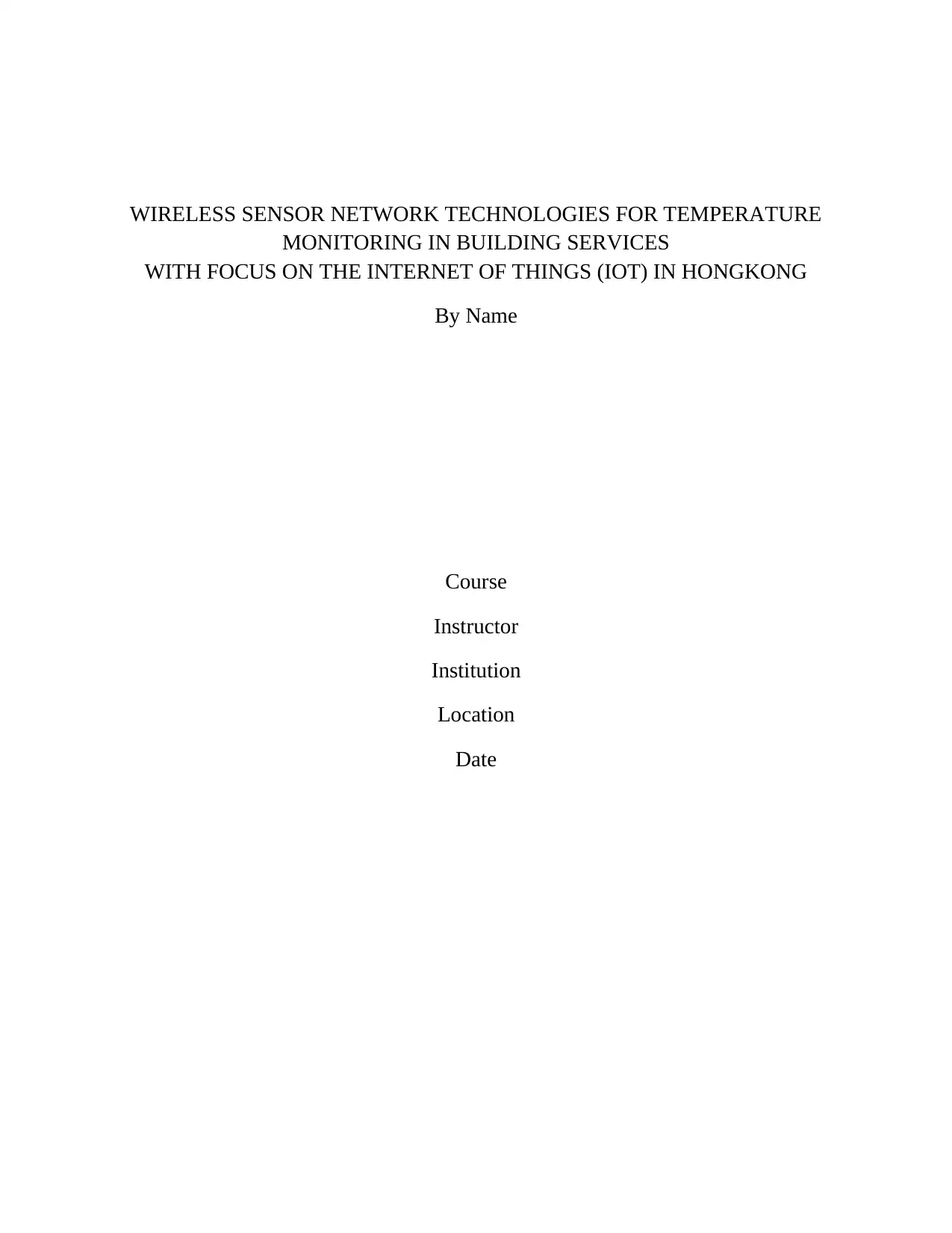
WIRELESS SENSOR NETWORK TECHNOLOGIES FOR TEMPERATURE
MONITORING IN BUILDING SERVICES
WITH FOCUS ON THE INTERNET OF THINGS (IOT) IN HONGKONG
By Name
Course
Instructor
Institution
Location
Date
MONITORING IN BUILDING SERVICES
WITH FOCUS ON THE INTERNET OF THINGS (IOT) IN HONGKONG
By Name
Course
Instructor
Institution
Location
Date
Paraphrase This Document
Need a fresh take? Get an instant paraphrase of this document with our AI Paraphraser
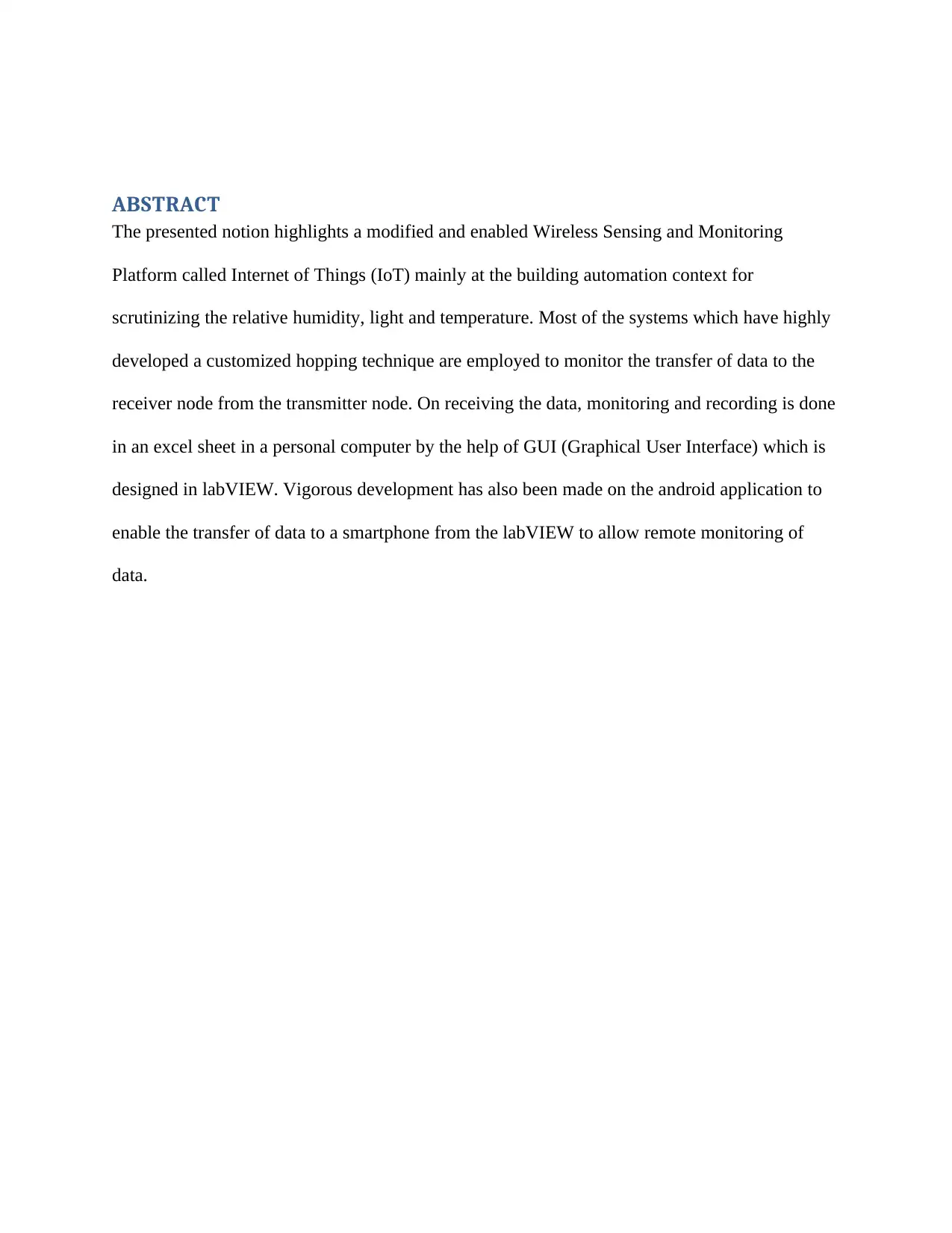
ABSTRACT
The presented notion highlights a modified and enabled Wireless Sensing and Monitoring
Platform called Internet of Things (IoT) mainly at the building automation context for
scrutinizing the relative humidity, light and temperature. Most of the systems which have highly
developed a customized hopping technique are employed to monitor the transfer of data to the
receiver node from the transmitter node. On receiving the data, monitoring and recording is done
in an excel sheet in a personal computer by the help of GUI (Graphical User Interface) which is
designed in labVIEW. Vigorous development has also been made on the android application to
enable the transfer of data to a smartphone from the labVIEW to allow remote monitoring of
data.
The presented notion highlights a modified and enabled Wireless Sensing and Monitoring
Platform called Internet of Things (IoT) mainly at the building automation context for
scrutinizing the relative humidity, light and temperature. Most of the systems which have highly
developed a customized hopping technique are employed to monitor the transfer of data to the
receiver node from the transmitter node. On receiving the data, monitoring and recording is done
in an excel sheet in a personal computer by the help of GUI (Graphical User Interface) which is
designed in labVIEW. Vigorous development has also been made on the android application to
enable the transfer of data to a smartphone from the labVIEW to allow remote monitoring of
data.
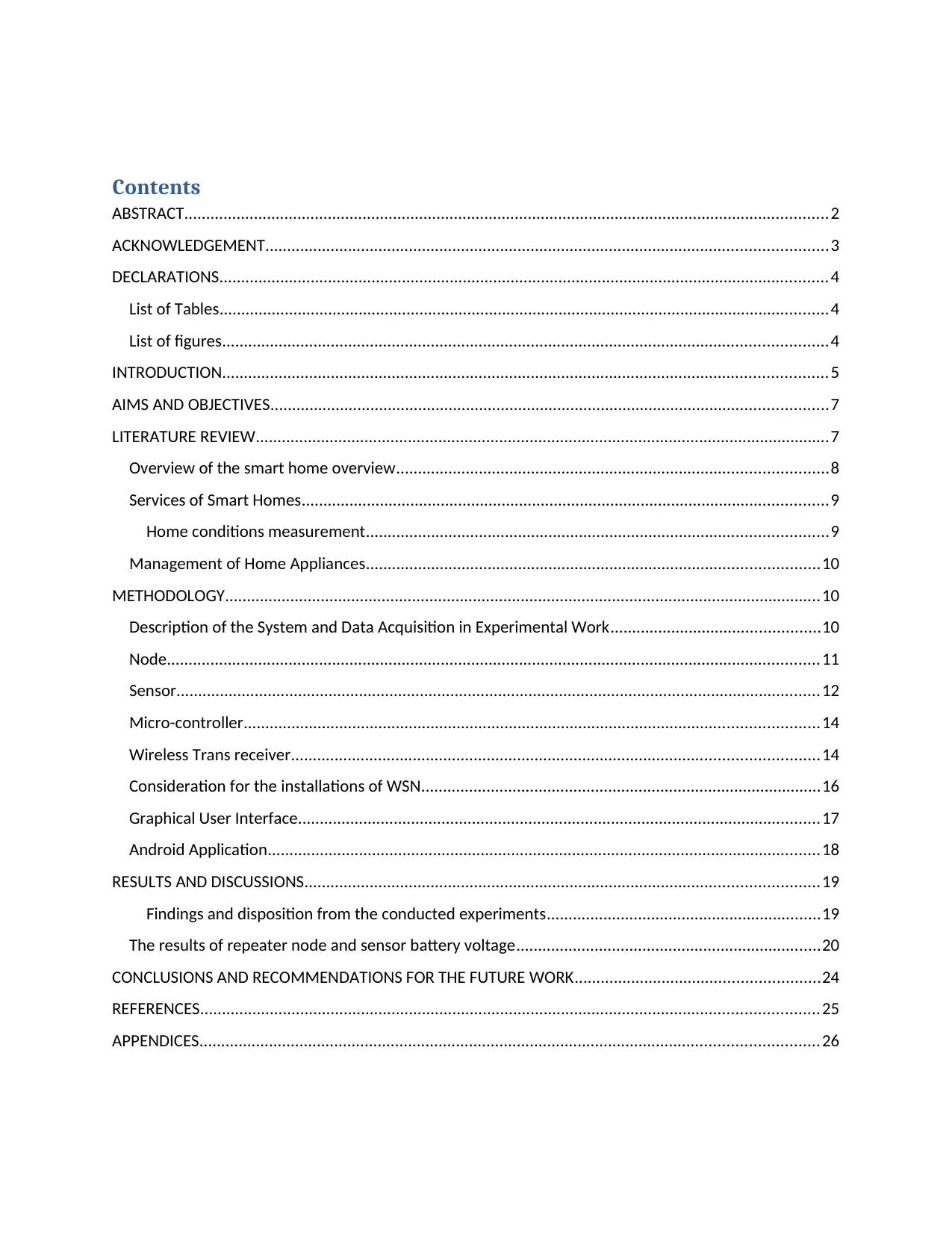
Contents
ABSTRACT....................................................................................................................................................2
ACKNOWLEDGEMENT.................................................................................................................................3
DECLARATIONS............................................................................................................................................4
List of Tables............................................................................................................................................4
List of figures...........................................................................................................................................4
INTRODUCTION...........................................................................................................................................5
AIMS AND OBJECTIVES................................................................................................................................7
LITERATURE REVIEW....................................................................................................................................7
Overview of the smart home overview...................................................................................................8
Services of Smart Homes.........................................................................................................................9
Home conditions measurement..........................................................................................................9
Management of Home Appliances........................................................................................................10
METHODOLOGY.........................................................................................................................................10
Description of the System and Data Acquisition in Experimental Work................................................10
Node......................................................................................................................................................11
Sensor....................................................................................................................................................12
Micro-controller....................................................................................................................................14
Wireless Trans receiver.........................................................................................................................14
Consideration for the installations of WSN............................................................................................16
Graphical User Interface........................................................................................................................17
Android Application...............................................................................................................................18
RESULTS AND DISCUSSIONS......................................................................................................................19
Findings and disposition from the conducted experiments...............................................................19
The results of repeater node and sensor battery voltage......................................................................20
CONCLUSIONS AND RECOMMENDATIONS FOR THE FUTURE WORK........................................................24
REFERENCES..............................................................................................................................................25
APPENDICES..............................................................................................................................................26
ABSTRACT....................................................................................................................................................2
ACKNOWLEDGEMENT.................................................................................................................................3
DECLARATIONS............................................................................................................................................4
List of Tables............................................................................................................................................4
List of figures...........................................................................................................................................4
INTRODUCTION...........................................................................................................................................5
AIMS AND OBJECTIVES................................................................................................................................7
LITERATURE REVIEW....................................................................................................................................7
Overview of the smart home overview...................................................................................................8
Services of Smart Homes.........................................................................................................................9
Home conditions measurement..........................................................................................................9
Management of Home Appliances........................................................................................................10
METHODOLOGY.........................................................................................................................................10
Description of the System and Data Acquisition in Experimental Work................................................10
Node......................................................................................................................................................11
Sensor....................................................................................................................................................12
Micro-controller....................................................................................................................................14
Wireless Trans receiver.........................................................................................................................14
Consideration for the installations of WSN............................................................................................16
Graphical User Interface........................................................................................................................17
Android Application...............................................................................................................................18
RESULTS AND DISCUSSIONS......................................................................................................................19
Findings and disposition from the conducted experiments...............................................................19
The results of repeater node and sensor battery voltage......................................................................20
CONCLUSIONS AND RECOMMENDATIONS FOR THE FUTURE WORK........................................................24
REFERENCES..............................................................................................................................................25
APPENDICES..............................................................................................................................................26
⊘ This is a preview!⊘
Do you want full access?
Subscribe today to unlock all pages.

Trusted by 1+ million students worldwide

ACKNOWLEDGEMENT
It is of common knowledge that a project can only be regarded complete when it is supplemented
by words of encouragement. And for that I’m totally obliged to Mr.………………… for being of
great help to the team in providing the correct path and relative suggestions throughout the entire
project. I may lack the exact words to express my thanks to him but I greatly submit to his help,
for he provided the vigorous effort in the endeavor, observing a close interaction in every step I
made and providing me with the necessary advice at every stage of the project development. Let
me pass my gratitude to those whom I have interacted with for their contribution and the
responsibilities they have observed.
It is of common knowledge that a project can only be regarded complete when it is supplemented
by words of encouragement. And for that I’m totally obliged to Mr.………………… for being of
great help to the team in providing the correct path and relative suggestions throughout the entire
project. I may lack the exact words to express my thanks to him but I greatly submit to his help,
for he provided the vigorous effort in the endeavor, observing a close interaction in every step I
made and providing me with the necessary advice at every stage of the project development. Let
me pass my gratitude to those whom I have interacted with for their contribution and the
responsibilities they have observed.
Paraphrase This Document
Need a fresh take? Get an instant paraphrase of this document with our AI Paraphraser
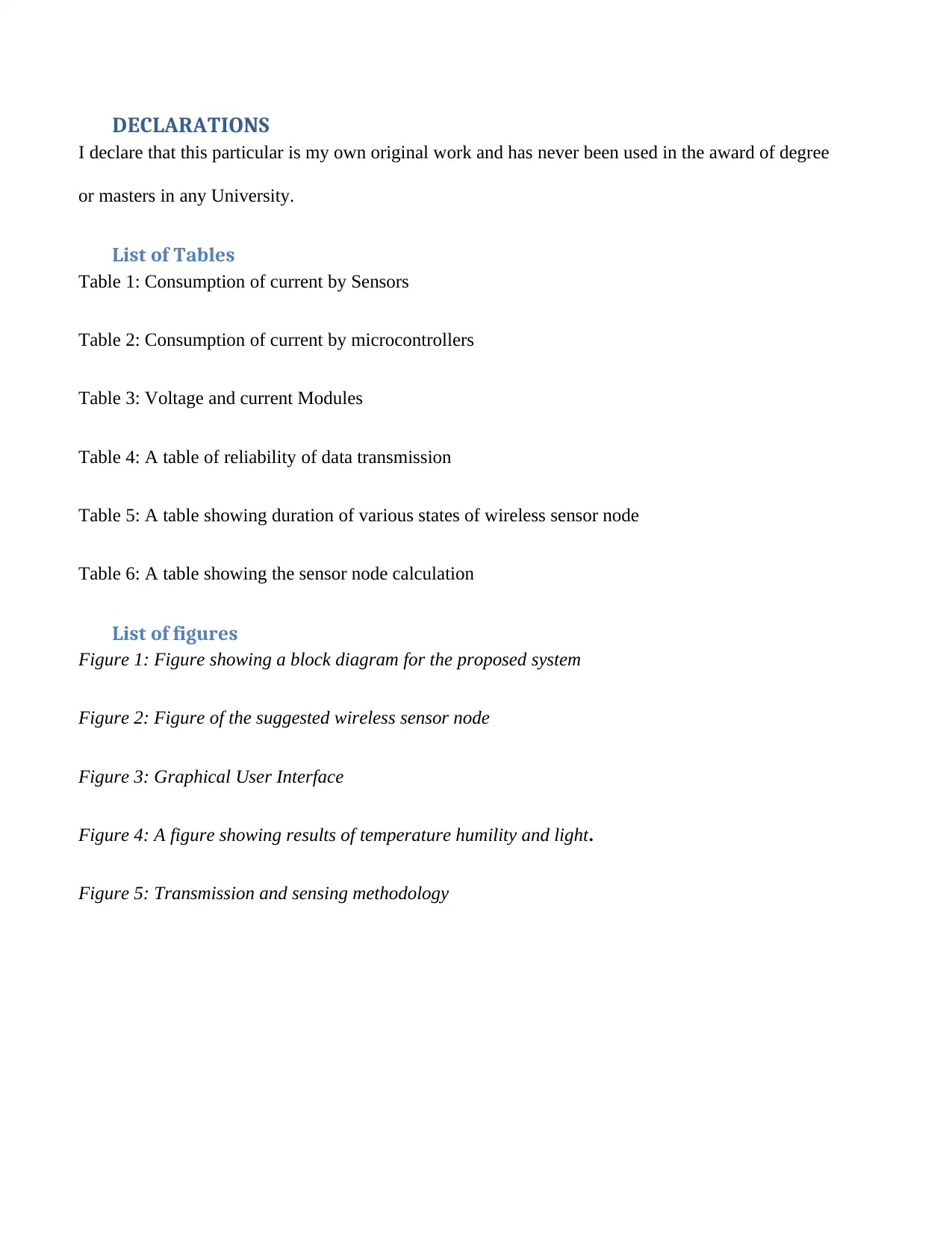
DECLARATIONS
I declare that this particular is my own original work and has never been used in the award of degree
or masters in any University.
List of Tables
Table 1: Consumption of current by Sensors
Table 2: Consumption of current by microcontrollers
Table 3: Voltage and current Modules
Table 4: A table of reliability of data transmission
Table 5: A table showing duration of various states of wireless sensor node
Table 6: A table showing the sensor node calculation
List of figures
Figure 1: Figure showing a block diagram for the proposed system
Figure 2: Figure of the suggested wireless sensor node
Figure 3: Graphical User Interface
Figure 4: A figure showing results of temperature humility and light.
Figure 5: Transmission and sensing methodology
I declare that this particular is my own original work and has never been used in the award of degree
or masters in any University.
List of Tables
Table 1: Consumption of current by Sensors
Table 2: Consumption of current by microcontrollers
Table 3: Voltage and current Modules
Table 4: A table of reliability of data transmission
Table 5: A table showing duration of various states of wireless sensor node
Table 6: A table showing the sensor node calculation
List of figures
Figure 1: Figure showing a block diagram for the proposed system
Figure 2: Figure of the suggested wireless sensor node
Figure 3: Graphical User Interface
Figure 4: A figure showing results of temperature humility and light.
Figure 5: Transmission and sensing methodology
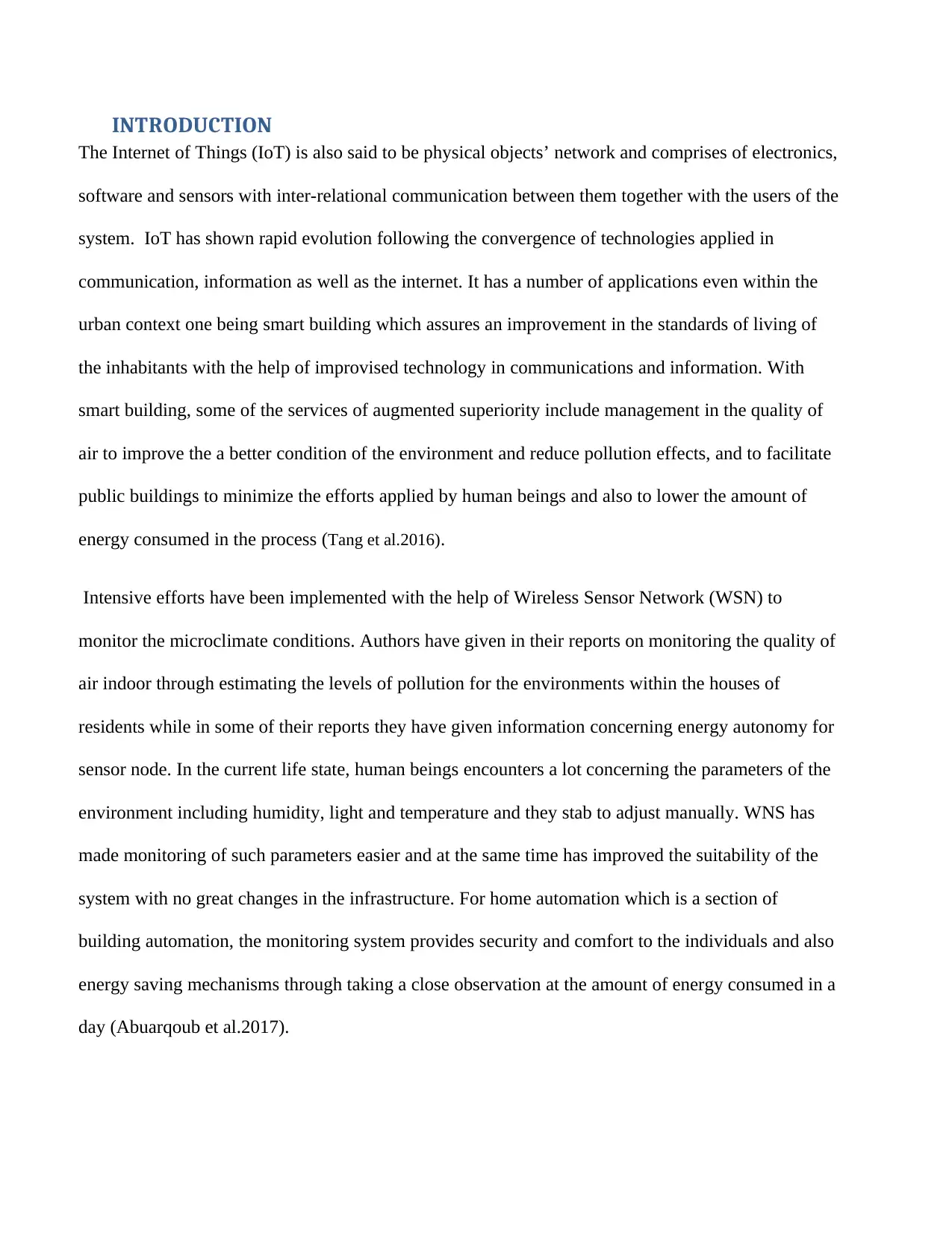
INTRODUCTION
The Internet of Things (IoT) is also said to be physical objects’ network and comprises of electronics,
software and sensors with inter-relational communication between them together with the users of the
system. IoT has shown rapid evolution following the convergence of technologies applied in
communication, information as well as the internet. It has a number of applications even within the
urban context one being smart building which assures an improvement in the standards of living of
the inhabitants with the help of improvised technology in communications and information. With
smart building, some of the services of augmented superiority include management in the quality of
air to improve the a better condition of the environment and reduce pollution effects, and to facilitate
public buildings to minimize the efforts applied by human beings and also to lower the amount of
energy consumed in the process (Tang et al.2016).
Intensive efforts have been implemented with the help of Wireless Sensor Network (WSN) to
monitor the microclimate conditions. Authors have given in their reports on monitoring the quality of
air indoor through estimating the levels of pollution for the environments within the houses of
residents while in some of their reports they have given information concerning energy autonomy for
sensor node. In the current life state, human beings encounters a lot concerning the parameters of the
environment including humidity, light and temperature and they stab to adjust manually. WNS has
made monitoring of such parameters easier and at the same time has improved the suitability of the
system with no great changes in the infrastructure. For home automation which is a section of
building automation, the monitoring system provides security and comfort to the individuals and also
energy saving mechanisms through taking a close observation at the amount of energy consumed in a
day (Abuarqoub et al.2017).
The Internet of Things (IoT) is also said to be physical objects’ network and comprises of electronics,
software and sensors with inter-relational communication between them together with the users of the
system. IoT has shown rapid evolution following the convergence of technologies applied in
communication, information as well as the internet. It has a number of applications even within the
urban context one being smart building which assures an improvement in the standards of living of
the inhabitants with the help of improvised technology in communications and information. With
smart building, some of the services of augmented superiority include management in the quality of
air to improve the a better condition of the environment and reduce pollution effects, and to facilitate
public buildings to minimize the efforts applied by human beings and also to lower the amount of
energy consumed in the process (Tang et al.2016).
Intensive efforts have been implemented with the help of Wireless Sensor Network (WSN) to
monitor the microclimate conditions. Authors have given in their reports on monitoring the quality of
air indoor through estimating the levels of pollution for the environments within the houses of
residents while in some of their reports they have given information concerning energy autonomy for
sensor node. In the current life state, human beings encounters a lot concerning the parameters of the
environment including humidity, light and temperature and they stab to adjust manually. WNS has
made monitoring of such parameters easier and at the same time has improved the suitability of the
system with no great changes in the infrastructure. For home automation which is a section of
building automation, the monitoring system provides security and comfort to the individuals and also
energy saving mechanisms through taking a close observation at the amount of energy consumed in a
day (Abuarqoub et al.2017).
⊘ This is a preview!⊘
Do you want full access?
Subscribe today to unlock all pages.

Trusted by 1+ million students worldwide
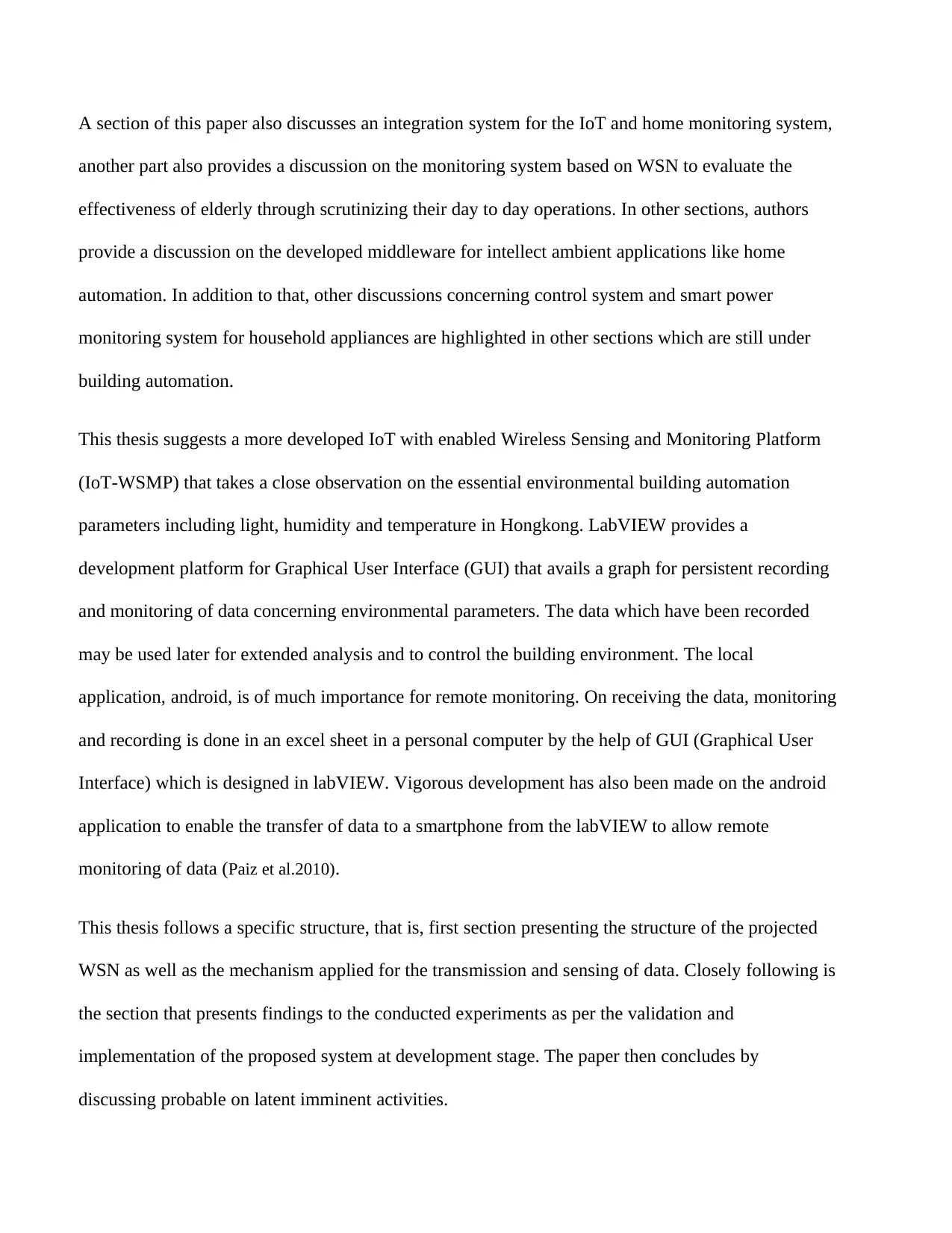
A section of this paper also discusses an integration system for the IoT and home monitoring system,
another part also provides a discussion on the monitoring system based on WSN to evaluate the
effectiveness of elderly through scrutinizing their day to day operations. In other sections, authors
provide a discussion on the developed middleware for intellect ambient applications like home
automation. In addition to that, other discussions concerning control system and smart power
monitoring system for household appliances are highlighted in other sections which are still under
building automation.
This thesis suggests a more developed IoT with enabled Wireless Sensing and Monitoring Platform
(IoT-WSMP) that takes a close observation on the essential environmental building automation
parameters including light, humidity and temperature in Hongkong. LabVIEW provides a
development platform for Graphical User Interface (GUI) that avails a graph for persistent recording
and monitoring of data concerning environmental parameters. The data which have been recorded
may be used later for extended analysis and to control the building environment. The local
application, android, is of much importance for remote monitoring. On receiving the data, monitoring
and recording is done in an excel sheet in a personal computer by the help of GUI (Graphical User
Interface) which is designed in labVIEW. Vigorous development has also been made on the android
application to enable the transfer of data to a smartphone from the labVIEW to allow remote
monitoring of data (Paiz et al.2010).
This thesis follows a specific structure, that is, first section presenting the structure of the projected
WSN as well as the mechanism applied for the transmission and sensing of data. Closely following is
the section that presents findings to the conducted experiments as per the validation and
implementation of the proposed system at development stage. The paper then concludes by
discussing probable on latent imminent activities.
another part also provides a discussion on the monitoring system based on WSN to evaluate the
effectiveness of elderly through scrutinizing their day to day operations. In other sections, authors
provide a discussion on the developed middleware for intellect ambient applications like home
automation. In addition to that, other discussions concerning control system and smart power
monitoring system for household appliances are highlighted in other sections which are still under
building automation.
This thesis suggests a more developed IoT with enabled Wireless Sensing and Monitoring Platform
(IoT-WSMP) that takes a close observation on the essential environmental building automation
parameters including light, humidity and temperature in Hongkong. LabVIEW provides a
development platform for Graphical User Interface (GUI) that avails a graph for persistent recording
and monitoring of data concerning environmental parameters. The data which have been recorded
may be used later for extended analysis and to control the building environment. The local
application, android, is of much importance for remote monitoring. On receiving the data, monitoring
and recording is done in an excel sheet in a personal computer by the help of GUI (Graphical User
Interface) which is designed in labVIEW. Vigorous development has also been made on the android
application to enable the transfer of data to a smartphone from the labVIEW to allow remote
monitoring of data (Paiz et al.2010).
This thesis follows a specific structure, that is, first section presenting the structure of the projected
WSN as well as the mechanism applied for the transmission and sensing of data. Closely following is
the section that presents findings to the conducted experiments as per the validation and
implementation of the proposed system at development stage. The paper then concludes by
discussing probable on latent imminent activities.
Paraphrase This Document
Need a fresh take? Get an instant paraphrase of this document with our AI Paraphraser
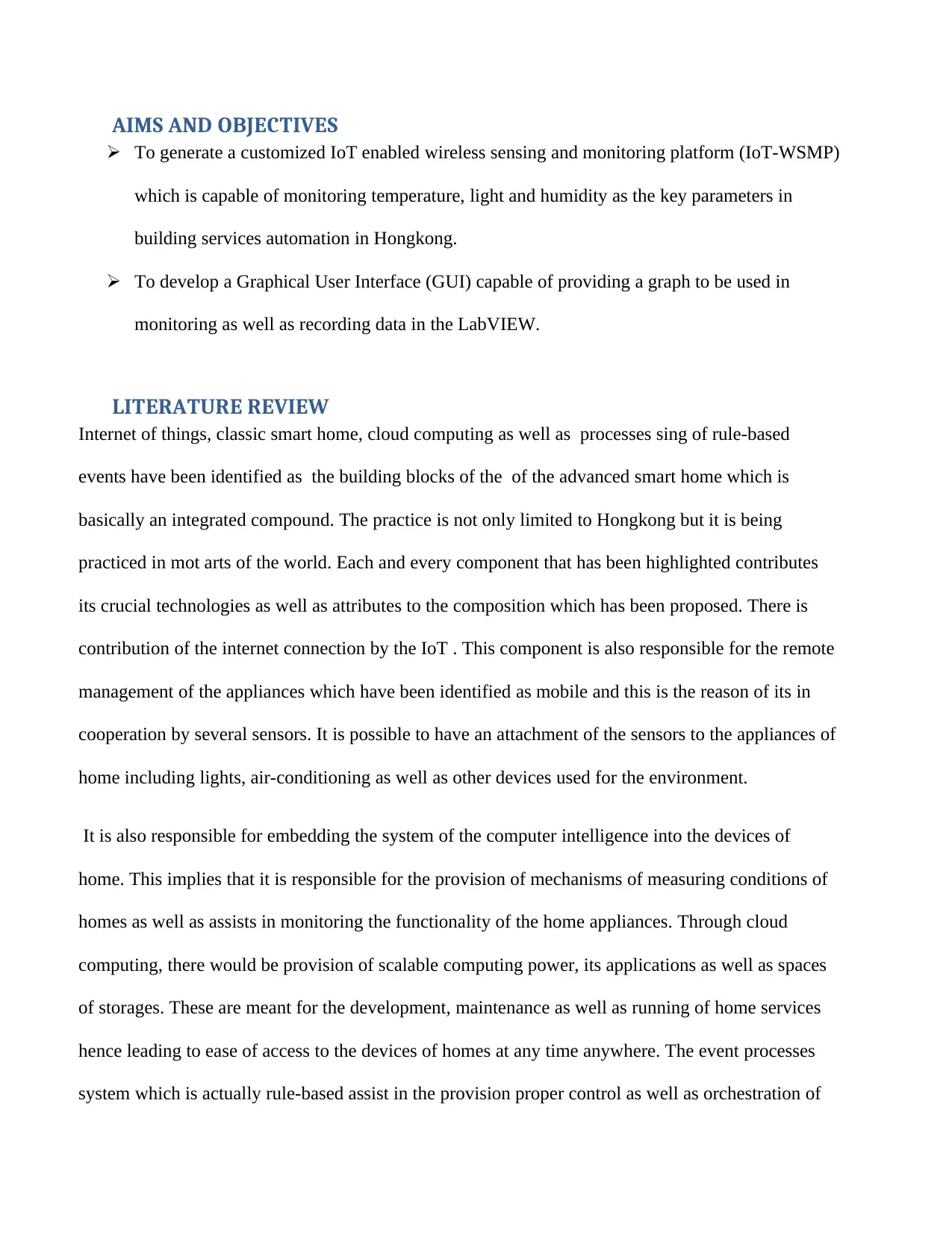
AIMS AND OBJECTIVES
To generate a customized IoT enabled wireless sensing and monitoring platform (IoT-WSMP)
which is capable of monitoring temperature, light and humidity as the key parameters in
building services automation in Hongkong.
To develop a Graphical User Interface (GUI) capable of providing a graph to be used in
monitoring as well as recording data in the LabVIEW.
LITERATURE REVIEW
Internet of things, classic smart home, cloud computing as well as processes sing of rule-based
events have been identified as the building blocks of the of the advanced smart home which is
basically an integrated compound. The practice is not only limited to Hongkong but it is being
practiced in mot arts of the world. Each and every component that has been highlighted contributes
its crucial technologies as well as attributes to the composition which has been proposed. There is
contribution of the internet connection by the IoT . This component is also responsible for the remote
management of the appliances which have been identified as mobile and this is the reason of its in
cooperation by several sensors. It is possible to have an attachment of the sensors to the appliances of
home including lights, air-conditioning as well as other devices used for the environment.
It is also responsible for embedding the system of the computer intelligence into the devices of
home. This implies that it is responsible for the provision of mechanisms of measuring conditions of
homes as well as assists in monitoring the functionality of the home appliances. Through cloud
computing, there would be provision of scalable computing power, its applications as well as spaces
of storages. These are meant for the development, maintenance as well as running of home services
hence leading to ease of access to the devices of homes at any time anywhere. The event processes
system which is actually rule-based assist in the provision proper control as well as orchestration of
To generate a customized IoT enabled wireless sensing and monitoring platform (IoT-WSMP)
which is capable of monitoring temperature, light and humidity as the key parameters in
building services automation in Hongkong.
To develop a Graphical User Interface (GUI) capable of providing a graph to be used in
monitoring as well as recording data in the LabVIEW.
LITERATURE REVIEW
Internet of things, classic smart home, cloud computing as well as processes sing of rule-based
events have been identified as the building blocks of the of the advanced smart home which is
basically an integrated compound. The practice is not only limited to Hongkong but it is being
practiced in mot arts of the world. Each and every component that has been highlighted contributes
its crucial technologies as well as attributes to the composition which has been proposed. There is
contribution of the internet connection by the IoT . This component is also responsible for the remote
management of the appliances which have been identified as mobile and this is the reason of its in
cooperation by several sensors. It is possible to have an attachment of the sensors to the appliances of
home including lights, air-conditioning as well as other devices used for the environment.
It is also responsible for embedding the system of the computer intelligence into the devices of
home. This implies that it is responsible for the provision of mechanisms of measuring conditions of
homes as well as assists in monitoring the functionality of the home appliances. Through cloud
computing, there would be provision of scalable computing power, its applications as well as spaces
of storages. These are meant for the development, maintenance as well as running of home services
hence leading to ease of access to the devices of homes at any time anywhere. The event processes
system which is actually rule-based assist in the provision proper control as well as orchestration of
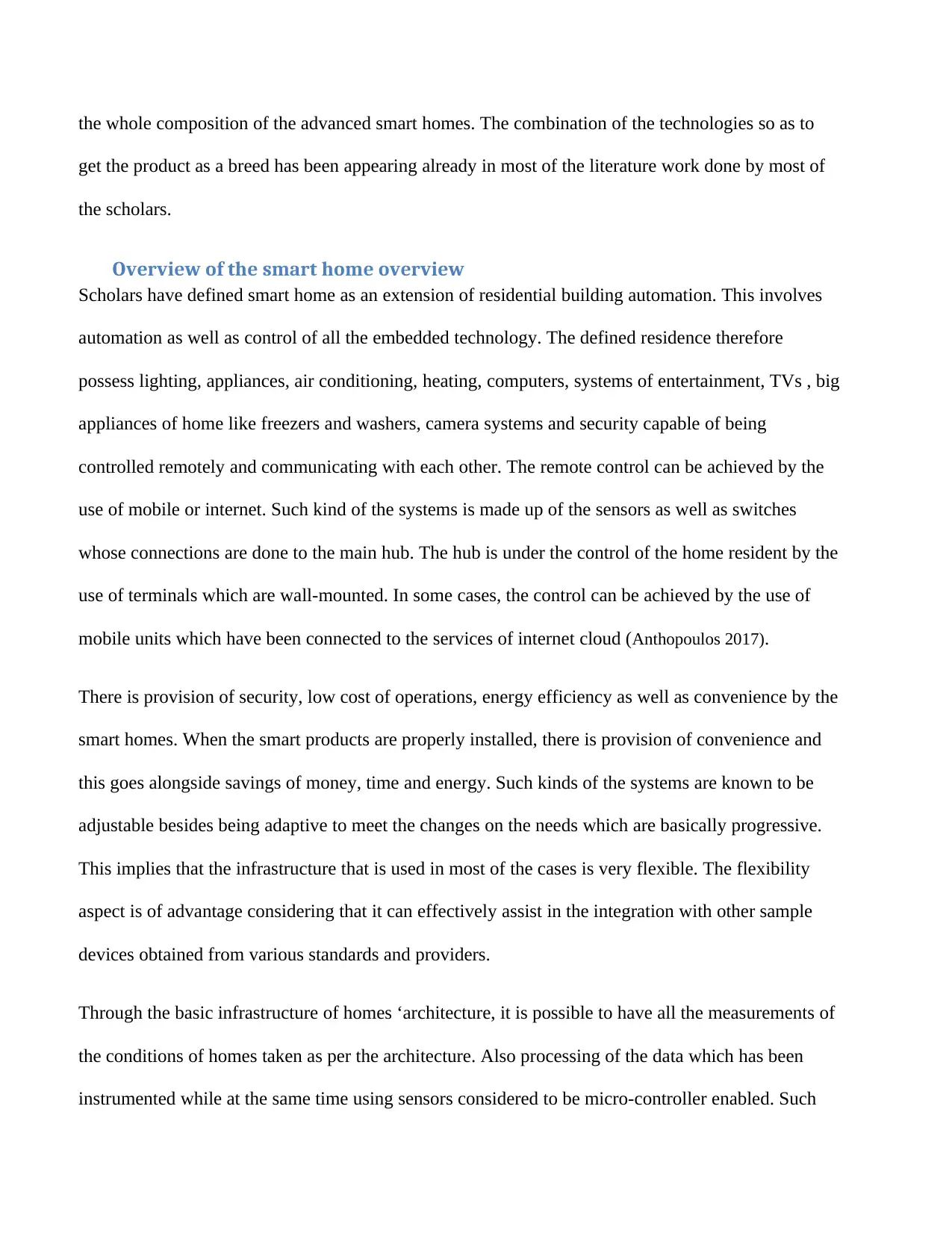
the whole composition of the advanced smart homes. The combination of the technologies so as to
get the product as a breed has been appearing already in most of the literature work done by most of
the scholars.
Overview of the smart home overview
Scholars have defined smart home as an extension of residential building automation. This involves
automation as well as control of all the embedded technology. The defined residence therefore
possess lighting, appliances, air conditioning, heating, computers, systems of entertainment, TVs , big
appliances of home like freezers and washers, camera systems and security capable of being
controlled remotely and communicating with each other. The remote control can be achieved by the
use of mobile or internet. Such kind of the systems is made up of the sensors as well as switches
whose connections are done to the main hub. The hub is under the control of the home resident by the
use of terminals which are wall-mounted. In some cases, the control can be achieved by the use of
mobile units which have been connected to the services of internet cloud (Anthopoulos 2017).
There is provision of security, low cost of operations, energy efficiency as well as convenience by the
smart homes. When the smart products are properly installed, there is provision of convenience and
this goes alongside savings of money, time and energy. Such kinds of the systems are known to be
adjustable besides being adaptive to meet the changes on the needs which are basically progressive.
This implies that the infrastructure that is used in most of the cases is very flexible. The flexibility
aspect is of advantage considering that it can effectively assist in the integration with other sample
devices obtained from various standards and providers.
Through the basic infrastructure of homes ‘architecture, it is possible to have all the measurements of
the conditions of homes taken as per the architecture. Also processing of the data which has been
instrumented while at the same time using sensors considered to be micro-controller enabled. Such
get the product as a breed has been appearing already in most of the literature work done by most of
the scholars.
Overview of the smart home overview
Scholars have defined smart home as an extension of residential building automation. This involves
automation as well as control of all the embedded technology. The defined residence therefore
possess lighting, appliances, air conditioning, heating, computers, systems of entertainment, TVs , big
appliances of home like freezers and washers, camera systems and security capable of being
controlled remotely and communicating with each other. The remote control can be achieved by the
use of mobile or internet. Such kind of the systems is made up of the sensors as well as switches
whose connections are done to the main hub. The hub is under the control of the home resident by the
use of terminals which are wall-mounted. In some cases, the control can be achieved by the use of
mobile units which have been connected to the services of internet cloud (Anthopoulos 2017).
There is provision of security, low cost of operations, energy efficiency as well as convenience by the
smart homes. When the smart products are properly installed, there is provision of convenience and
this goes alongside savings of money, time and energy. Such kinds of the systems are known to be
adjustable besides being adaptive to meet the changes on the needs which are basically progressive.
This implies that the infrastructure that is used in most of the cases is very flexible. The flexibility
aspect is of advantage considering that it can effectively assist in the integration with other sample
devices obtained from various standards and providers.
Through the basic infrastructure of homes ‘architecture, it is possible to have all the measurements of
the conditions of homes taken as per the architecture. Also processing of the data which has been
instrumented while at the same time using sensors considered to be micro-controller enabled. Such
⊘ This is a preview!⊘
Do you want full access?
Subscribe today to unlock all pages.

Trusted by 1+ million students worldwide
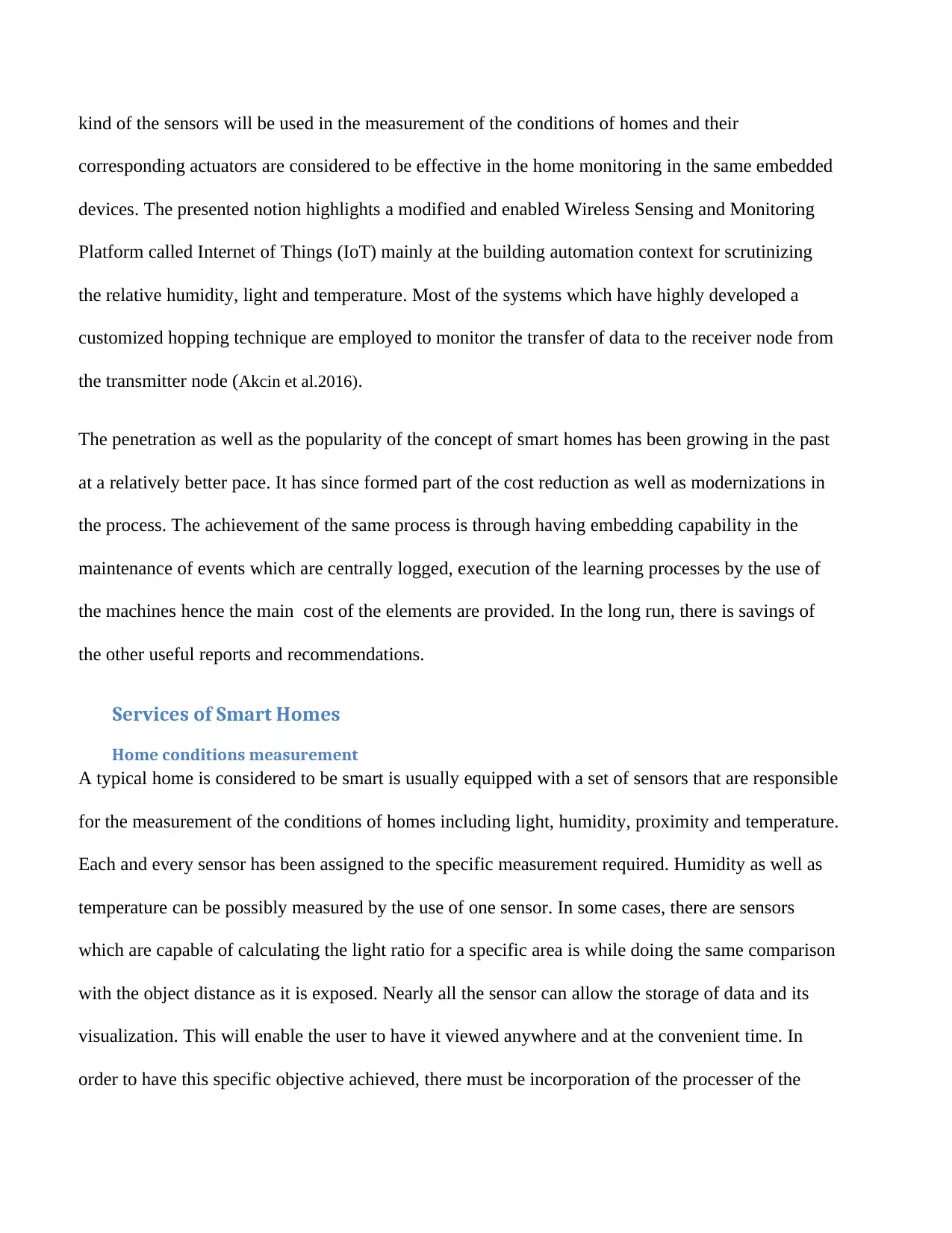
kind of the sensors will be used in the measurement of the conditions of homes and their
corresponding actuators are considered to be effective in the home monitoring in the same embedded
devices. The presented notion highlights a modified and enabled Wireless Sensing and Monitoring
Platform called Internet of Things (IoT) mainly at the building automation context for scrutinizing
the relative humidity, light and temperature. Most of the systems which have highly developed a
customized hopping technique are employed to monitor the transfer of data to the receiver node from
the transmitter node (Akcin et al.2016).
The penetration as well as the popularity of the concept of smart homes has been growing in the past
at a relatively better pace. It has since formed part of the cost reduction as well as modernizations in
the process. The achievement of the same process is through having embedding capability in the
maintenance of events which are centrally logged, execution of the learning processes by the use of
the machines hence the main cost of the elements are provided. In the long run, there is savings of
the other useful reports and recommendations.
Services of Smart Homes
Home conditions measurement
A typical home is considered to be smart is usually equipped with a set of sensors that are responsible
for the measurement of the conditions of homes including light, humidity, proximity and temperature.
Each and every sensor has been assigned to the specific measurement required. Humidity as well as
temperature can be possibly measured by the use of one sensor. In some cases, there are sensors
which are capable of calculating the light ratio for a specific area is while doing the same comparison
with the object distance as it is exposed. Nearly all the sensor can allow the storage of data and its
visualization. This will enable the user to have it viewed anywhere and at the convenient time. In
order to have this specific objective achieved, there must be incorporation of the processer of the
corresponding actuators are considered to be effective in the home monitoring in the same embedded
devices. The presented notion highlights a modified and enabled Wireless Sensing and Monitoring
Platform called Internet of Things (IoT) mainly at the building automation context for scrutinizing
the relative humidity, light and temperature. Most of the systems which have highly developed a
customized hopping technique are employed to monitor the transfer of data to the receiver node from
the transmitter node (Akcin et al.2016).
The penetration as well as the popularity of the concept of smart homes has been growing in the past
at a relatively better pace. It has since formed part of the cost reduction as well as modernizations in
the process. The achievement of the same process is through having embedding capability in the
maintenance of events which are centrally logged, execution of the learning processes by the use of
the machines hence the main cost of the elements are provided. In the long run, there is savings of
the other useful reports and recommendations.
Services of Smart Homes
Home conditions measurement
A typical home is considered to be smart is usually equipped with a set of sensors that are responsible
for the measurement of the conditions of homes including light, humidity, proximity and temperature.
Each and every sensor has been assigned to the specific measurement required. Humidity as well as
temperature can be possibly measured by the use of one sensor. In some cases, there are sensors
which are capable of calculating the light ratio for a specific area is while doing the same comparison
with the object distance as it is exposed. Nearly all the sensor can allow the storage of data and its
visualization. This will enable the user to have it viewed anywhere and at the convenient time. In
order to have this specific objective achieved, there must be incorporation of the processer of the
Paraphrase This Document
Need a fresh take? Get an instant paraphrase of this document with our AI Paraphraser
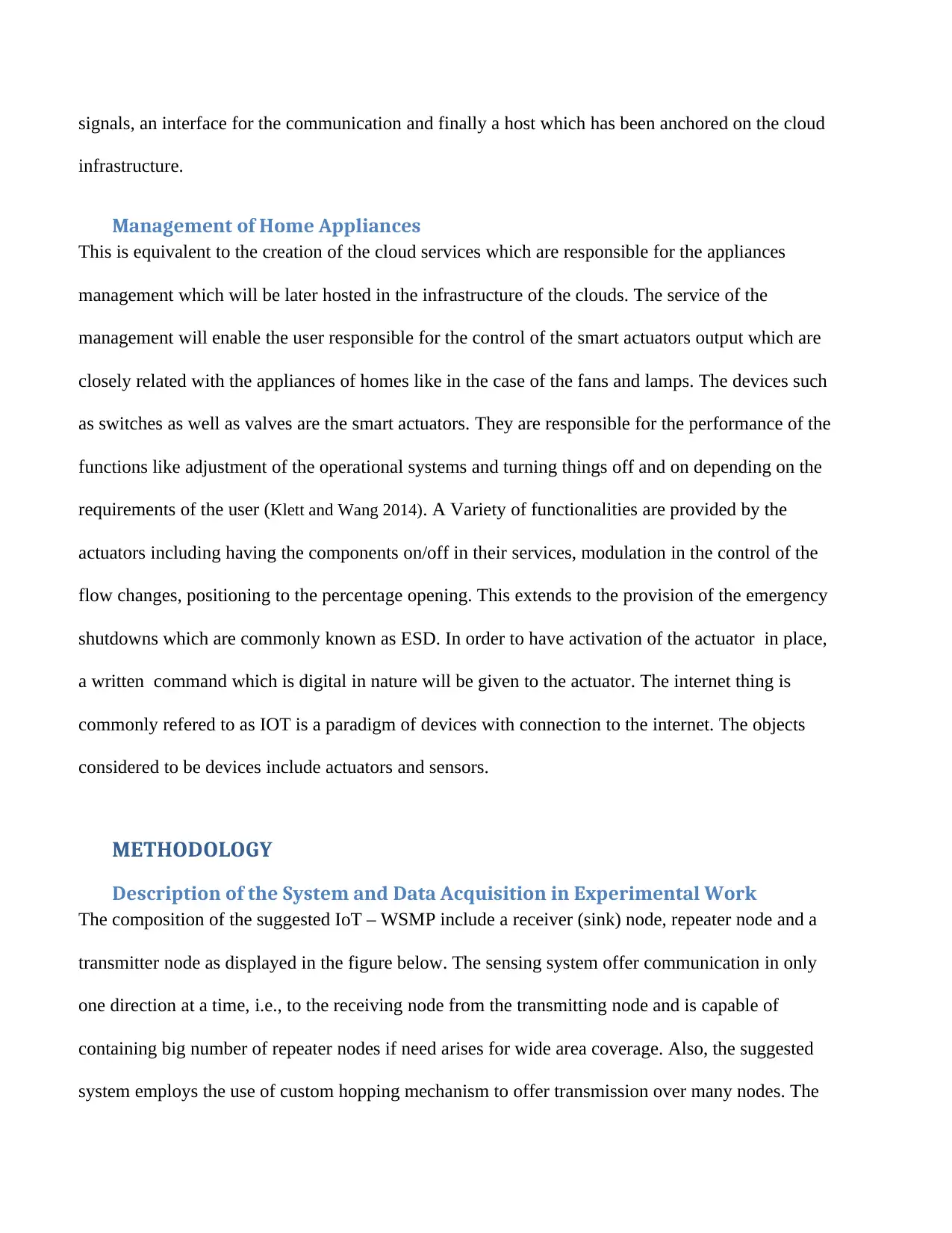
signals, an interface for the communication and finally a host which has been anchored on the cloud
infrastructure.
Management of Home Appliances
This is equivalent to the creation of the cloud services which are responsible for the appliances
management which will be later hosted in the infrastructure of the clouds. The service of the
management will enable the user responsible for the control of the smart actuators output which are
closely related with the appliances of homes like in the case of the fans and lamps. The devices such
as switches as well as valves are the smart actuators. They are responsible for the performance of the
functions like adjustment of the operational systems and turning things off and on depending on the
requirements of the user (Klett and Wang 2014). A Variety of functionalities are provided by the
actuators including having the components on/off in their services, modulation in the control of the
flow changes, positioning to the percentage opening. This extends to the provision of the emergency
shutdowns which are commonly known as ESD. In order to have activation of the actuator in place,
a written command which is digital in nature will be given to the actuator. The internet thing is
commonly refered to as IOT is a paradigm of devices with connection to the internet. The objects
considered to be devices include actuators and sensors.
METHODOLOGY
Description of the System and Data Acquisition in Experimental Work
The composition of the suggested IoT – WSMP include a receiver (sink) node, repeater node and a
transmitter node as displayed in the figure below. The sensing system offer communication in only
one direction at a time, i.e., to the receiving node from the transmitting node and is capable of
containing big number of repeater nodes if need arises for wide area coverage. Also, the suggested
system employs the use of custom hopping mechanism to offer transmission over many nodes. The
infrastructure.
Management of Home Appliances
This is equivalent to the creation of the cloud services which are responsible for the appliances
management which will be later hosted in the infrastructure of the clouds. The service of the
management will enable the user responsible for the control of the smart actuators output which are
closely related with the appliances of homes like in the case of the fans and lamps. The devices such
as switches as well as valves are the smart actuators. They are responsible for the performance of the
functions like adjustment of the operational systems and turning things off and on depending on the
requirements of the user (Klett and Wang 2014). A Variety of functionalities are provided by the
actuators including having the components on/off in their services, modulation in the control of the
flow changes, positioning to the percentage opening. This extends to the provision of the emergency
shutdowns which are commonly known as ESD. In order to have activation of the actuator in place,
a written command which is digital in nature will be given to the actuator. The internet thing is
commonly refered to as IOT is a paradigm of devices with connection to the internet. The objects
considered to be devices include actuators and sensors.
METHODOLOGY
Description of the System and Data Acquisition in Experimental Work
The composition of the suggested IoT – WSMP include a receiver (sink) node, repeater node and a
transmitter node as displayed in the figure below. The sensing system offer communication in only
one direction at a time, i.e., to the receiving node from the transmitting node and is capable of
containing big number of repeater nodes if need arises for wide area coverage. Also, the suggested
system employs the use of custom hopping mechanism to offer transmission over many nodes. The
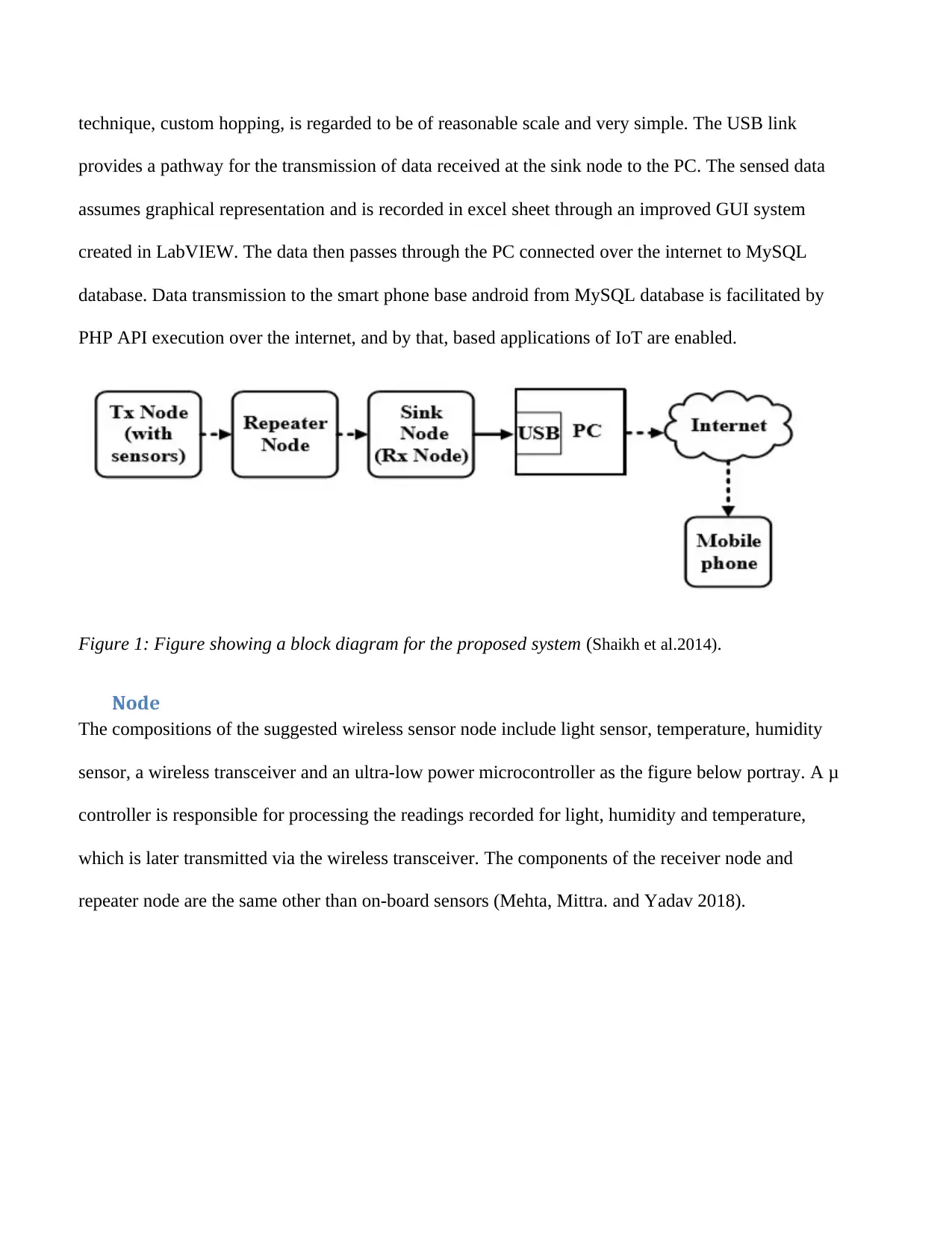
technique, custom hopping, is regarded to be of reasonable scale and very simple. The USB link
provides a pathway for the transmission of data received at the sink node to the PC. The sensed data
assumes graphical representation and is recorded in excel sheet through an improved GUI system
created in LabVIEW. The data then passes through the PC connected over the internet to MySQL
database. Data transmission to the smart phone base android from MySQL database is facilitated by
PHP API execution over the internet, and by that, based applications of IoT are enabled.
Figure 1: Figure showing a block diagram for the proposed system (Shaikh et al.2014).
Node
The compositions of the suggested wireless sensor node include light sensor, temperature, humidity
sensor, a wireless transceiver and an ultra-low power microcontroller as the figure below portray. A μ
controller is responsible for processing the readings recorded for light, humidity and temperature,
which is later transmitted via the wireless transceiver. The components of the receiver node and
repeater node are the same other than on-board sensors (Mehta, Mittra. and Yadav 2018).
provides a pathway for the transmission of data received at the sink node to the PC. The sensed data
assumes graphical representation and is recorded in excel sheet through an improved GUI system
created in LabVIEW. The data then passes through the PC connected over the internet to MySQL
database. Data transmission to the smart phone base android from MySQL database is facilitated by
PHP API execution over the internet, and by that, based applications of IoT are enabled.
Figure 1: Figure showing a block diagram for the proposed system (Shaikh et al.2014).
Node
The compositions of the suggested wireless sensor node include light sensor, temperature, humidity
sensor, a wireless transceiver and an ultra-low power microcontroller as the figure below portray. A μ
controller is responsible for processing the readings recorded for light, humidity and temperature,
which is later transmitted via the wireless transceiver. The components of the receiver node and
repeater node are the same other than on-board sensors (Mehta, Mittra. and Yadav 2018).
⊘ This is a preview!⊘
Do you want full access?
Subscribe today to unlock all pages.

Trusted by 1+ million students worldwide
1 out of 33
Related Documents
Your All-in-One AI-Powered Toolkit for Academic Success.
+13062052269
info@desklib.com
Available 24*7 on WhatsApp / Email
![[object Object]](/_next/static/media/star-bottom.7253800d.svg)
Unlock your academic potential
Copyright © 2020–2025 A2Z Services. All Rights Reserved. Developed and managed by ZUCOL.


